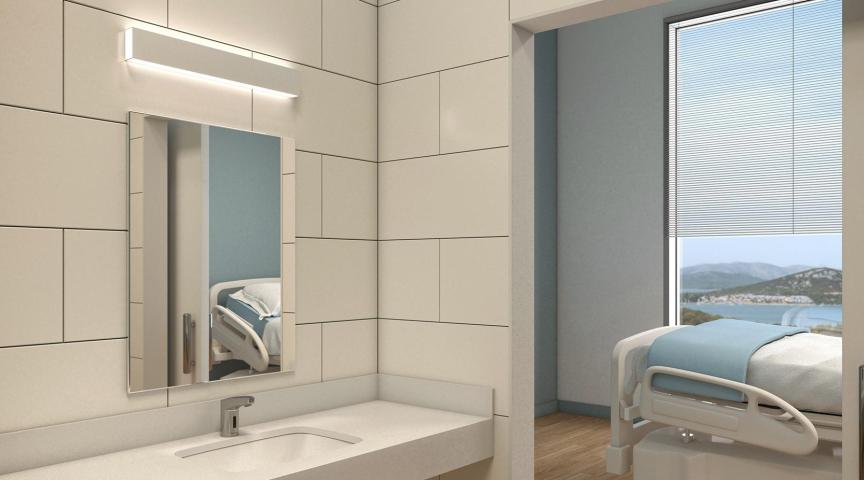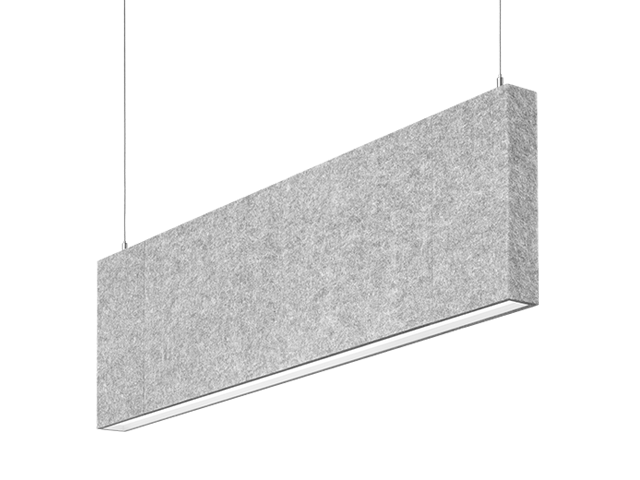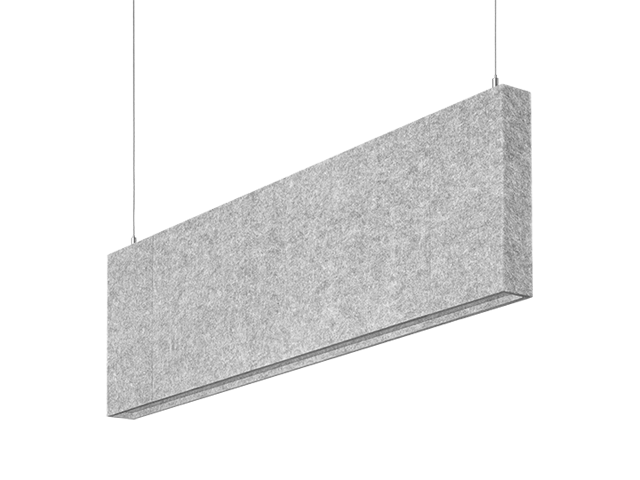Why Classroom Acoustics Matter
When it comes to creating equitable and effective learning environments, lighting and visibility often are the spotlight in school design. Yet, one of the most crucial factors for student success remains largely invisible: sound.
Acoustics play a critical role in how well students learn, engage, and retain information in classrooms and lecture halls, where instruction is predominantly auditory. Poor acoustic design can diminish academic outcomes and pose long-term consequences for student development and teacher well-being. As modern education evolves to prioritize inclusion, well-being, and performance, acoustic design must be part of the foundation, not an afterthought.


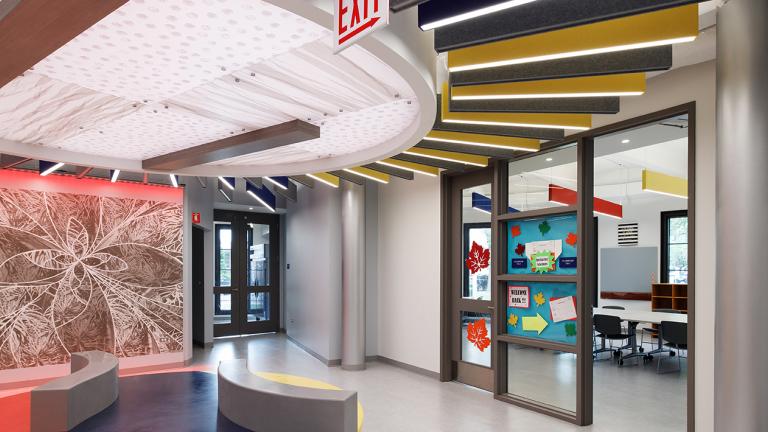
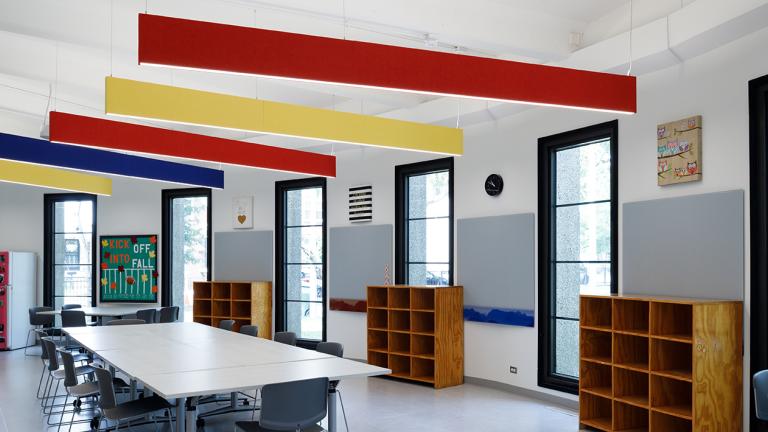
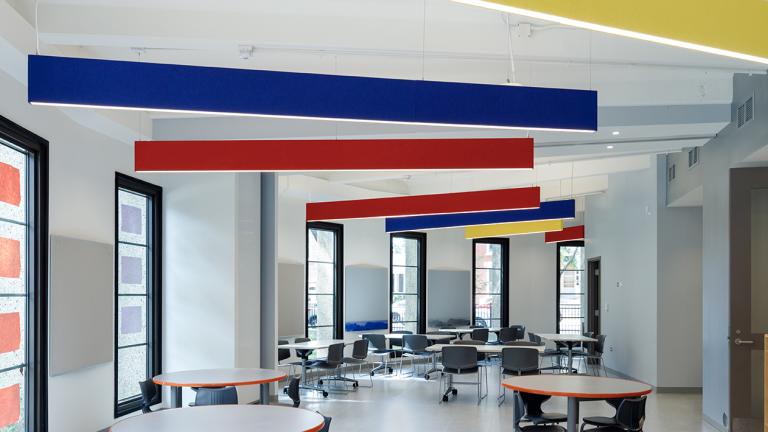
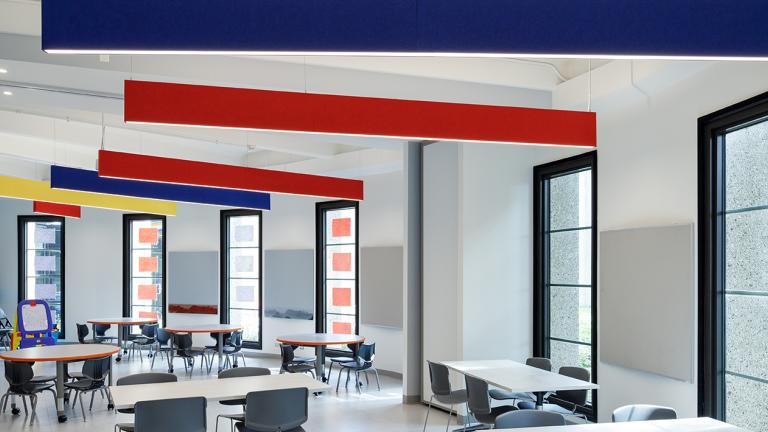
Hearing Is the First Step to Learning
The ability to hear clearly in educational settings directly impacts a student’s capability to understand instructions, stay focused, and interact confidently. According to the American Speech-Language-Hearing Association (ASHA), poor classroom acoustics interfere with core learning functions such as:
• Speech comprehension
• Reading, spelling, and language development
• Concentration and attention span
• Emotional regulation and classroom behavior
These challenges are even more pronounced for:
• Young children, whose auditory systems are still developing
• English language learners
• Students with hearing loss or auditory processing disorders
• Students with ADHD or other attention difficulties
In fact, children need a +15 dB signal-to-noise ratio (SNR) to clearly understand speech. Signal-to-Noise Ratio (SNR) is critical to ensuring that speech is heard clearly over background noise. Experts recommend a minimum SNR of +15 dB in classrooms, meaning that a teacher’s voice should be at least 15 decibels louder than the surrounding noise for students to understand speech accurately and with minimal listening effort. Many classrooms today fall short of this ideal, achieving only +5 to +7 dB, which can severely impact student comprehension and participation. In many cases, poor acoustics can turn into an accessibility barrier, similarly to how removing visual materials would hinder visual learners.
When Noise Becomes Cognitive Overload
Background noise and reverberation don’t just distract but also consume the mental energy students need for critical and higher-order thinking. This cognitive overload, also called listening fatigue, reduces the brain’s ability to process, remember, and respond to what’s being taught.
Research consistently shows that poor acoustic conditions result in:
- Lower reading and spelling scores
- Reduced listening comprehension
- Decreased task persistence
- Diminished classroom participation and self-confidence
Even modest changes can make a significant difference. For example, reducing the reverberation time (RT60) from 1.1 seconds to 0.6 seconds can improve word recognition by up to 40% (ASHA). This improvement is especially important given that 28% of U.S. classrooms exceed acceptable noise levels, according to the U.S. Green Building Council.

Math Performance Also Drops as Noise Levels Rise
Although the effect is less severe than in language tests, increased background noise still leads to a measurable decline in students’ math performance.

Language Skills Decline Sharply with Increased Noise
Higher ambient sound levels in classrooms correlate with significantly lower English test scores, suggesting that language processing is especially vulnerable to noise interference.

The Teacher’s Voice: A Silent Crisis
Teachers, too, suffer in poor acoustic environments. Many find themselves raising their voices to compete with HVAC noise, hallway chatter, or echoing surfaces. Over time, this leads to:
- Vocal strain and fatigue
- Increased risk of chronic voice disorders
- Shortened instructional time due to repetition
- Modified lesson plans that limit student interaction
A well-designed acoustic environment protects both student learning and teachers’ health.
What the Standards Say
To ensure all students have equal access to learning, classroom acoustics should follow the best practices as outlined by ANSI and WELL Building Standards. Both frameworks emphasize that noise and reverberation must be properly managed to minimize distraction, enhance speech intelligibility, and support cognitive performance:
- Reverberation Time (RT60):
- ≤ 0.6 seconds for classrooms under 20,000 ft3
- ≤ 1.0 seconds for lecture halls, auditoriums, and other larger learning spaces
- Sound Transmission Class (STC):
- ≥ 45 between learning and adjacent mechanical spaces
- For high-priority spaces like classrooms, STC 50+ is recommended by WELL
- Background Noise Level:
- ≤ 35 dBA, as recommended by ANSI and the World Health Organization (WHO)
- Signal-to-Noise Ratio (SNR):
- Recommended minimum of +15 dB, ensuring speech is clearly audible above ambient noise (per ASHA guidelines)
The WELL Building Standard, known for its evidence-based strategies to improve human health and performance in buildings, includes acoustics as a core component of its Sound Concept. It highlights that reducing unwanted noise and improving speech clarity directly supports learning, focus, and well-being, particularly for young children and neurodiverse students.
With rising attention on inclusive design, many school districts and design firms now look to frameworks like CHPS (Collaborative for High Performance Schools) and LEED for Schools, which prioritize acoustic performance in education spaces. These evolving standards reflect a growing understanding that good acoustics are essential to equity, well-being, and long-term academic success.
Unfortunately, these benchmarks are rarely met in aging or acoustically neglected classrooms, especially those built with hard, reflective surfaces like concrete, tile, or glass. Prioritizing acoustic design from the start is essential to creating healthy, inclusive learning environments.

Sound Solutions for Better Classrooms
Designing good acoustics requires a combination of passive and active strategies, integrated early in the architectural process:
Passive Treatments
- Acoustic ceiling systems
- Wall panels
- Carpeting or soft flooring
- Furniture with sound-dampening features
Active Systems
- Classroom audio distribution or sound field amplification
- HVAC systems designed with low-noise performance
Design Considerations
- Avoid dominance of hard, reflective surfaces
- Combine lighting and acoustic design from the outset to maximize performance and aesthetics
- Consider the layout of open-plan or multi-use learning spaces that need careful zoning
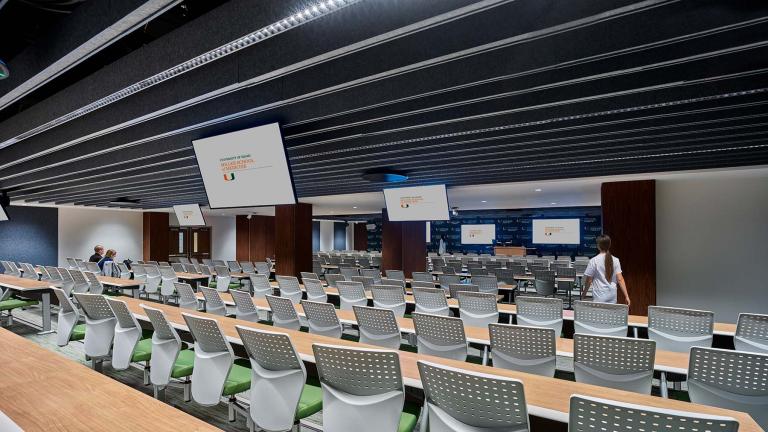
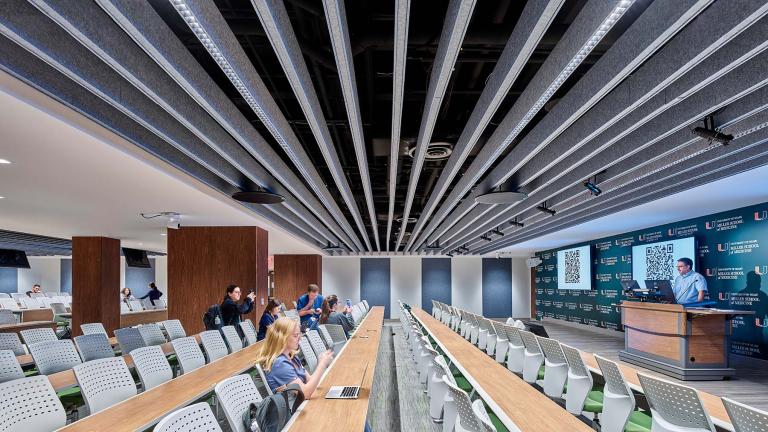
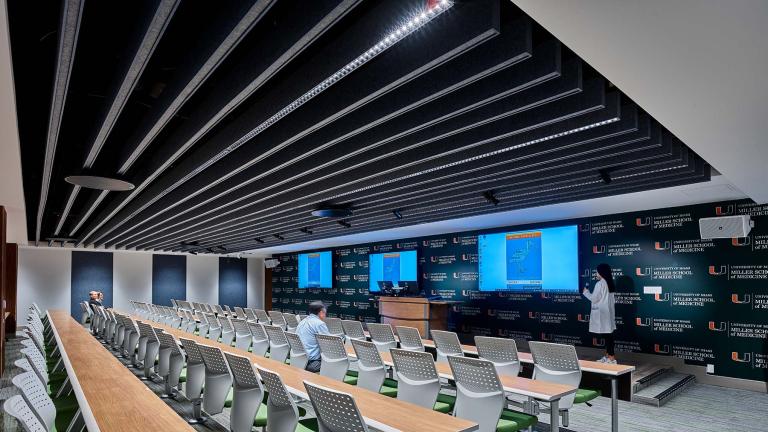
Focal Point Acoustic Solutions
Acoustic challenges vary by space, but the goal is the same: to create environments that enhance focus, learning, and wellbeing. Focal Point offers a range of integrated acoustic lighting and ceiling solutions that address reverberation, glare, and visual comfort, all while adding architectural interest.
With integrated acoustic and lighting products like Seem® 1 Acoustic, designers can address both acoustic and lighting needs with one coordinated solution, streamlining specification while enhancing performance.
Take the University of Miami Miller School of Medicine, for example, where a 4,300-square-foot classroom was transformed into a lecture hall using Seem 1 Acoustic Louver and Unlit baffles. These were arranged in continuous runs to control reverberation while maintaining visual consistency across the ceiling, ensuring that every lecture is clearly heard, not just seen. The louvers contribute uniquely comfortable lighting and minimize the appearance of the “lines of light”, resulting in a cohesive ceiling appearance.
Why Classroom Acoustics Matter
When it comes to creating equitable and effective learning environments, lighting and visibility often are the spotlight in school design. Yet, one of the most crucial factors for student success remains largely invisible: sound.
Acoustics play a critical role in how well students learn, engage, and retain information in classrooms and lecture halls, where instruction is predominantly auditory. Poor acoustic design can diminish academic outcomes and pose long-term consequences for student development and teacher well-being. As modern education evolves to prioritize inclusion, well-being, and performance, acoustic design must be part of the foundation, not an afterthought.
In other education and multi-use facilities like McGuane Park in Chicago and Lakeland Elementary school building, Seem 1 Acoustic baffles are thoughtfully incorporated to support different activities, from focused learning to community gatherings, while reinforcing brand identity through color and form.
Even in glass-heavy spaces, AirCore Bridge® provides acoustic control without sacrificing daylight, as demonstrated in the lecture hall-style conference room at Boulevard 40 in Northbrook, Illinois. These are just a few examples of how Focal Point's acoustic solutions go beyond noise reduction – they help shape environments that are visually inspiring, acoustically optimized, and human-centered.
Featured Products
Helpful Resources
- American Speech-Language-Hearing Association (ASHA) Classroom Acoustics: Overview of how classroom acoustics affect speech understanding, behavior, and learning outcomes.
- ANSI/ASA S12.60/Part 1-2010 (R2020): Acoustical Performance - ANSI Blog: Defines acoustic performance standards for learning spaces, including background noise limits (≤ 35 dBA) and recommended reverberation times (≤ 0.6 seconds).
- Collaborative for High Performance Schools (CHPS):
A framework for school design focused on sustainability and student performance, including acoustic criteria. - Ecophon: Impact of Noise in Education:
Research-based insights into how poor acoustics impact younger students and ESL learners. - USGBC | U.S. Green Building Council:
Provides rating systems like LEED for Schools that incorporate acoustic design in broader sustainability goals. - Spaces4Learning- How the Right Acoustic Ceiling Can Improve a School's Performance:
Explores how acoustic ceilings improve school performance and meet ADA/ IDEA requirements. - Spaces4Learning- Elevating Acoustic Design for Optimal Learning Environments:
Case studies on designing educational spaces with acoustics as a central priority - WELL v2 and educational spaces: Promoting healthy schools:
WELL Building Standard guidance for acoustic comfort in educational environments, supporting student wellbeing and focus.








